Characterization of Breakdown Arcs Induced by Venting Particles Generated by Thermal Runaway of Large-Capacity Ternary Lithium-Ion Batteries
Abstract
:1. Introduction
2. Experimental
2.1. Venting Particles Collected after TR
2.2. Arc Testing System
- (1)
- To investigate the relationship between particle size and critical breakdown voltage: The electrode gap was fixed at 4 mm, and the particle size was varied. Five groups of particles with different sizes were used as test samples, with the load resistor set to 20 Ω.
- (2)
- To investigate the relationship between electrode spacing and critical breakdown voltage: Particle groups with sizes ranging from 300 to 500 μm were selected, and the load resistor was set to 20 Ω. The electrode gap was adjusted to 1 mm, 2 mm, 4 mm, 6 mm, and 8 mm.
- (3)
- To investigate the relationship between load resistance and critical breakdown voltage: Particles with sizes ranging from 300 to 500 μm were selected, and the electrode gap was set to 1 mm, 2 mm, and 4 mm. The effects of load resistors of 20 Ω and 30 Ω on the critical breakdown voltage were compared under different electrode gaps.
3. Results and Discussion
3.1. Characterization Results
3.1.1. Particle Size Analysis
3.1.2. Scanning Electron Microscopy Results
3.1.3. ICP-OES Elemental Analysis Results
3.2. The Impact of Particles with Different Sizes on Arc Initiation
3.3. The Impact of Different Electrode Gaps on Arc Initiation
3.4. The Impact of Different Load Resistance on Induced Arc Generation
4. Conclusions
Author Contributions
Funding
Data Availability Statement
Acknowledgments
Conflicts of Interest
References
- Li, X.Y.; Yuan, C.G.; Wang, Z.P.; He, J.T.; Yu, S.K. Lithium battery state-of-health estimation and remaining useful lifetime prediction based on non-parametric aging model and particle filter algorithm. eTransportation 2022, 11, 11. [Google Scholar] [CrossRef]
- Li, Y.L.; Wei, Y.F.; Zhu, F.Q.; Du, J.Y.; Zhao, Z.M.; Ouyang, M.G. The path enabling storage of renewable energy toward carbon neutralization in China. eTransportation 2023, 16, 11. [Google Scholar] [CrossRef]
- Steinstraeter, M.; Buberger, J.; Minnerup, K.; Trifonov, D.; Horner, P.; Weiss, B.; Lienkamp, M. Controlling cabin heating to improve range and battery lifetime of electric vehicles. eTransportation 2022, 13, 19. [Google Scholar] [CrossRef]
- Li, Y.L.; Feng, X.N.; Ren, D.S.; Ouyang, M.G.; Lu, L.G.; Han, X.B. Thermal Runaway Triggered by Plated Lithium on the Anode after Fast Charging. ACS Appl. Mater. Interfaces 2019, 11, 46839–46850. [Google Scholar] [CrossRef] [PubMed]
- Sun, P.Y.; Bisschop, R.; Niu, H.H.; Huang, X.Y. A Review of Battery Fires in Electric Vehicles. Fire Technol. 2020, 56, 1361–1410. [Google Scholar] [CrossRef]
- Wang, Q.S.; Ping, P.; Zhao, X.J.; Chu, G.Q.; Sun, J.H.; Chen, C.H. Thermal runaway caused fire and explosion of lithium ion battery. J. Power Sources 2012, 208, 210–224. [Google Scholar] [CrossRef]
- Fernandes, Y.; Bry, A.; De Persis, S. Identification and quantification of gases emitted during abuse tests by overcharge of a commercial Li-ion battery. J. Power Sources 2018, 389, 106–119. [Google Scholar] [CrossRef]
- Meng, X.; Li, S.; Fu, W.; Chen, Y.; Duan, Q.; Wang, Q. Experimental study of intermittent spray cooling on suppression for lithium iron phosphate battery fires. eTransportation 2022, 11, 100142. [Google Scholar] [CrossRef]
- Piao, N.; Gao, X.; Yang, H.; Guo, Z.; Hu, G.; Cheng, H.-M.; Li, F. Challenges and development of lithium-ion batteries for low temperature environments. eTransportation 2022, 11, 100145. [Google Scholar] [CrossRef]
- Finegan, D.P.; Scheel, M.; Robinson, J.B.; Tjaden, B.; Hunt, I.; Mason, T.J.; Millichamp, J.; Di Michiel, M.; Offer, G.J.; Hinds, G. In-operando high-speed tomography of lithium-ion batteries during thermal runaway. Nat. Commun. 2015, 6, 6924. [Google Scholar] [CrossRef]
- Sloop, S.E.; Kerr, J.B.; Kinoshita, K. The role of Li-ion battery electrolyte reactivity in performance decline and self-discharge. J. Power Sources 2003, 119, 330–337. [Google Scholar] [CrossRef]
- Zhang, Y.J.; Wang, H.W.; Li, W.F.; Li, C.; Ouyang, M.G. Size distribution and elemental composition of vent particles from abused prismatic Ni-rich automotive lithium-ion batteries. J. Energy Storage 2019, 26, 7. [Google Scholar] [CrossRef]
- Bolshova, T.; Shvartsberg, V.; Shmakov, A.G. Synergism of trimethylphosphate and carbon dioxide in extinguishing premixed flames. Fire Saf. J. 2021, 125, 103406. [Google Scholar] [CrossRef]
- Weiss, M.; Ruess, R.; Kasnatscheew, J.; Levartovsky, Y.; Levy, N.R.; Minnmann, P.; Stolz, L.; Waldmann, T.; Wohlfahrt-Mehrens, M.; Aurbach, D.; et al. Fast charging of lithium-ion batteries: A review of materials aspects. Adv. Energy Mater. 2021, 11, 2101126. [Google Scholar] [CrossRef]
- Saada, R.; Patel, D.; Saha, B. Causes and consequences of thermal runaway incidents—Will they ever be avoided? Process Saf. Environ. Prot. 2015, 97, 109–115. [Google Scholar] [CrossRef]
- Xu, B.; Lee, J.; Kwon, D.; Kong, L.; Pecht, M. Mitigation strategies for Li-ion battery thermal runaway: A review. Renew. Sustain. Energy Rev. 2021, 150, 111437. [Google Scholar] [CrossRef]
- Galushkin, N.; Yazvinskaya, N.; Galushkin, D.N. Mechanism of thermal runaway in lithium-ion cells. J. Electrochem. Soc. 2018, 165, A1303. [Google Scholar] [CrossRef]
- Mallick, S.; Gayen, D. Thermal behaviour and thermal runaway propagation in lithium-ion battery systems—A critical review. J. Energy Storage 2023, 62, 106894. [Google Scholar] [CrossRef]
- Eoker, G. Electrode-components-of-the-arc-discharge. In Ergebnisse der Exakten Naturwissenschaften; Springer: Berlin/Heidelberg, Germany, 1961; pp. 1–104. [Google Scholar]
- Rabie, M.; Franck, C.M. Comparison of gases for electrical insulation: Fundamental concepts. IEEE Trans. Dielectr. Electr. Insul. 2018, 25, 649–656. [Google Scholar] [CrossRef]
- Ammerman, R.F.; Gammon, T.; Sen, P.K.; Nelson, J.P. Dc Arc Models and Incident Energy Calculations. In Proceedings of the 56th Annual Petroleum and Chemical Industry Conference, Anaheim, CA, USA, 14–16 September 2009; p. 61. [Google Scholar]
- Shkol’nik, S.M. Anode phenomena in arc discharges: A review. Plasma Sources Sci. Technol. 2011, 20, 31. [Google Scholar] [CrossRef]
- Hoerauf, R.; Shipp, D.D. Characteristics and applications of various arc interrupting methods. IEEE Trans. Ind. Appl. 1991, 27, 849–861. [Google Scholar] [CrossRef]
- Dashti, R.; Daisy, M.; Mirshekali, H.; Shaker, H.R.; Aliabadi, M.H. A survey of fault prediction and location methods in electrical energy distribution networks. Measurement 2021, 184, 30. [Google Scholar] [CrossRef]
- Guo, L.; Ke, X.; Tang, Y.; Chen, Y.; Li, Y.; Liu, Z. Design of Arc Fault Detection Method and Test System for New Energy Automobiles. Insul. Mater. 2018, 51, 74–79. [Google Scholar] [CrossRef]
- New Energy Vehicles Are Suspected to Self-Ignition during Draging, with Sparks Emitting from the Bottom Accompanied by Explosive Sounds. Available online: https://tv.sohu.com/v/dXMvMzg1MjY0MzIzLzQyMzY5MzQ3Mi5zaHRtbA==.html?key=/v/dXMvMzg1MjY0MzIzLzQyMzY5MzQ3Mi5zaHRtbA==.html&vid=423693472 (accessed on 10 May 2024).
- Fisher Engineering, Inc. Report of Technical Findings: Victorian Big Battery Fire; 2021. Available online: https://infrastructure.planninginspectorate.gov.uk/wp-content/ipc/uploads/projects/EN010106/EN010106-004097-DL2%20-%20Edmund%20Fordham%20EF20.pdf (accessed on 7 August 2024).
- Shen, H.; Wang, H.; Li, M.; Li, C.; Zhang, Y.; Li, Y.; Yang, X.; Feng, X.; Ouyang, M. Thermal runaway characteristics and gas composition analysis of lithium-ion batteries with different LFP and NCM cathode materials under inert atmosphere. Electronics 2023, 12, 1603. [Google Scholar] [CrossRef]
- Lu, S.; Phung, B.; Zhang, D. A comprehensive review on DC arc faults and their diagnosis methods in photovoltaic systems. Renew. Sustain. Energy Rev. 2018, 89, 88–98. [Google Scholar] [CrossRef]
- Xu, W.Q.; Wu, X.G.; Li, Y.L.; Wang, H.W.; Lu, L.G.; Ouyang, M.G. A comprehensive review of DC arc faults and their mechanisms, detection, early warning strategies, and protection in battery systems. Renew. Sust. Energ. Rev. 2023, 186, 21. [Google Scholar] [CrossRef]
- Wang, J. Simulation of gas discharge in tube and Paschen’s law. Opt. Photonics J. 2013, 3, 313–317. [Google Scholar] [CrossRef]
- Wang, R.G.; Ji, Q.Z.; Zhang, T.K.; Xia, Q.; Zhang, Y.; Ouyang, J.T. Discharge characteristics of a needle-to-plate electrode at a micro-scale gap. Plasma Sci. Technol. 2018, 20, 5. [Google Scholar] [CrossRef]
- Wang, G.Q.; Kong, D.P.; Ping, P.; Wen, J.; He, X.Q.; Zhao, H.L.; He, X.; Peng, R.Q.; Zhang, Y.; Dai, X.Y. Revealing particle venting of lithium-ion batteries during thermal runaway: A multi-scale model toward multiphase process. eTransportation 2023, 16, 20. [Google Scholar] [CrossRef]
- Börger, A.; Mertens, J.; Wenzl, H. Thermal runaway and thermal runaway propagation in batteries: What do we talk about? J. Energy Storage 2019, 24, 100649. [Google Scholar] [CrossRef]
- Liao, Z.; Zhang, S.; Li, K.; Zhang, G.; Habetler, T.G. A survey of methods for monitoring and detecting thermal runaway of lithium-ion batteries. J. Power Sources 2019, 436, 226879. [Google Scholar] [CrossRef]
- Ledinski, T.; Golubkov, A.W.; Schweighofer, O.; Erker, S. Arcing in Li-Ion Batteries. Batteries 2023, 9, 21. [Google Scholar] [CrossRef]
- Shahid, S.; Agelin-Chaab, M. A review of thermal runaway prevention and mitigation strategies for lithium-ion batteries. Energy Convers. Manag. X 2022, 16, 100310. [Google Scholar] [CrossRef]
- Shi, Z.; Kang, Y.; Zhang, J.; Li, S.; Li, H. A novel theoretical model of gas–solid two-phase flow mixed dielectric discharge. Phys. Fluids 2022, 34, 113309. [Google Scholar] [CrossRef]
- Kong, L.; Li, Y.; Feng, W. Strategies to solve lithium battery thermal runaway: From mechanism to modification. Electrochem. Energy Rev. 2021, 4, 633–679. [Google Scholar] [CrossRef]
- Yao, W.; He, Z.; Deng, H.; Wang, G.; Zhang, M.; Ma, J.; Li, J.; Ye, Q.; Hu, H. Effects of Macroparticle Sizes on Two-phase Mixture Discharge Under DC Voltage. Proc. CSEE 2012, 32, 144–151. [Google Scholar]
- Li, W.F.; Xue, Y.; Feng, X.B.; Rao, S.; Zhang, T.Y.; Gao, Z.H.; Guo, Y.M.; Zhou, H.Y.; Zhao, H.Y.; Song, Z.L.; et al. Characteristics of particle emissions from lithium-ion batteries during thermal runaway: A review. J. Energy Storage 2024, 78, 17. [Google Scholar] [CrossRef]
- Yao, W.J.; He, Z.H.; Deng, H.M.; Li, J.; Ma, J. Experimental Investigation of Two-Phase Mixture Discharges Under DC Voltage From Effects of Macroparticle Sizes. IEEE Trans. Plasma Sci. 2011, 39, 856–864. [Google Scholar] [CrossRef]
- Fukuoka, Y.; Yasuoka, T.; Kato, K.; Okubo, H. Breakdown conditioning characteristics of long gap electrodes in a vacuum. IEEE Trans. Dielectr. Electr. Insul. 2007, 14, 577–582. [Google Scholar] [CrossRef]
- Pilan, N.; Deambrosis, S.M.; De Lorenzi, A.; Fincato, M.; Fontana, C.; Gobbo, R.; Lotto, L.; Martines, E.; Mc Cormack, O.; Pasqualotto, R.; et al. Study of high DC voltage breakdown between stainless steel electrodes separated by long vacuum gaps. Nucl. Fusion 2020, 60, 17. [Google Scholar] [CrossRef]
- Li, C.; Wang, H.; Li, Y.; Lu, L. Venting Particle-induced Arc of Lithium-ion Batteries During the Thermal Runaway. eTransportation 2024, 22, 100350. [Google Scholar] [CrossRef]

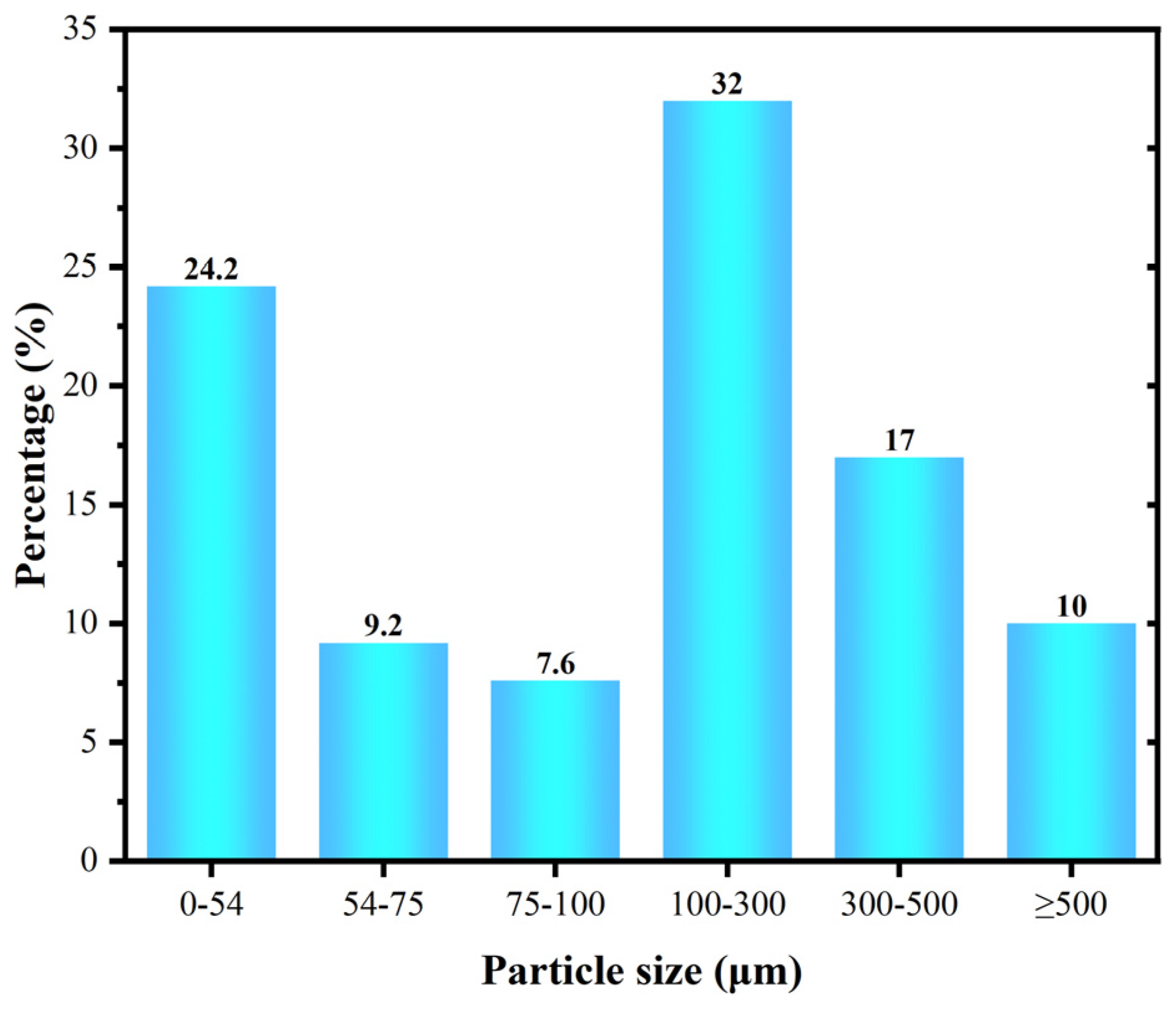
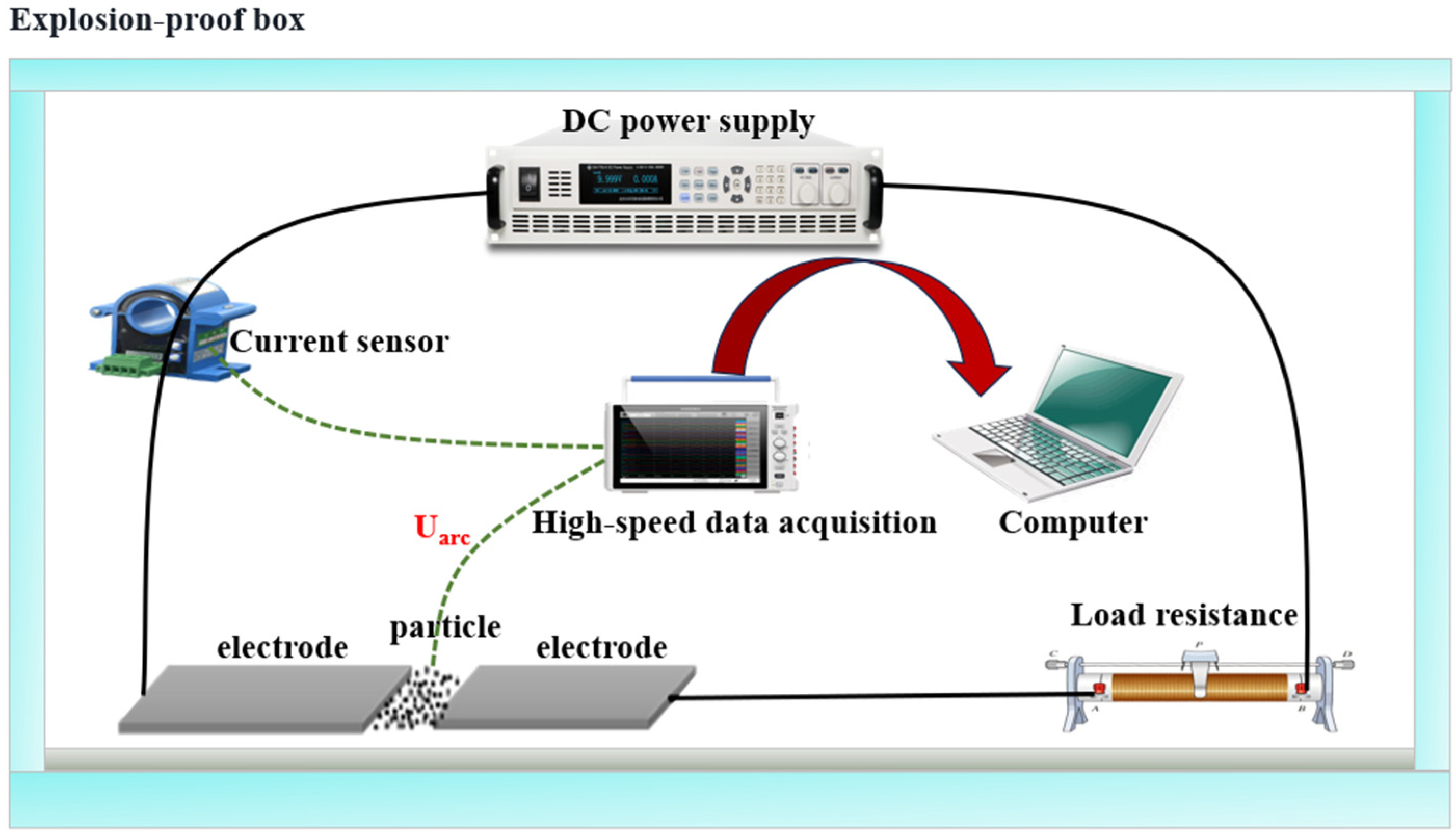
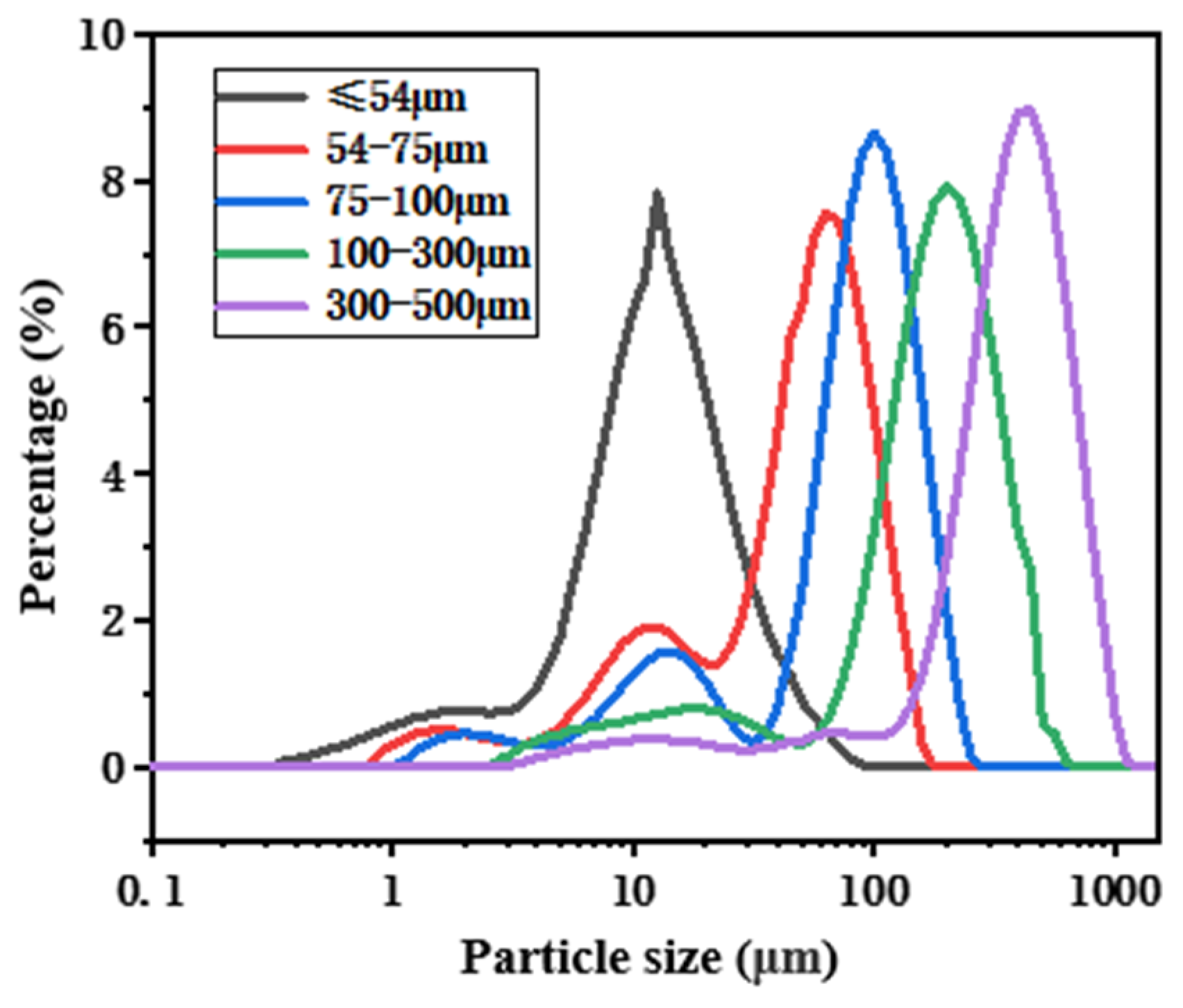
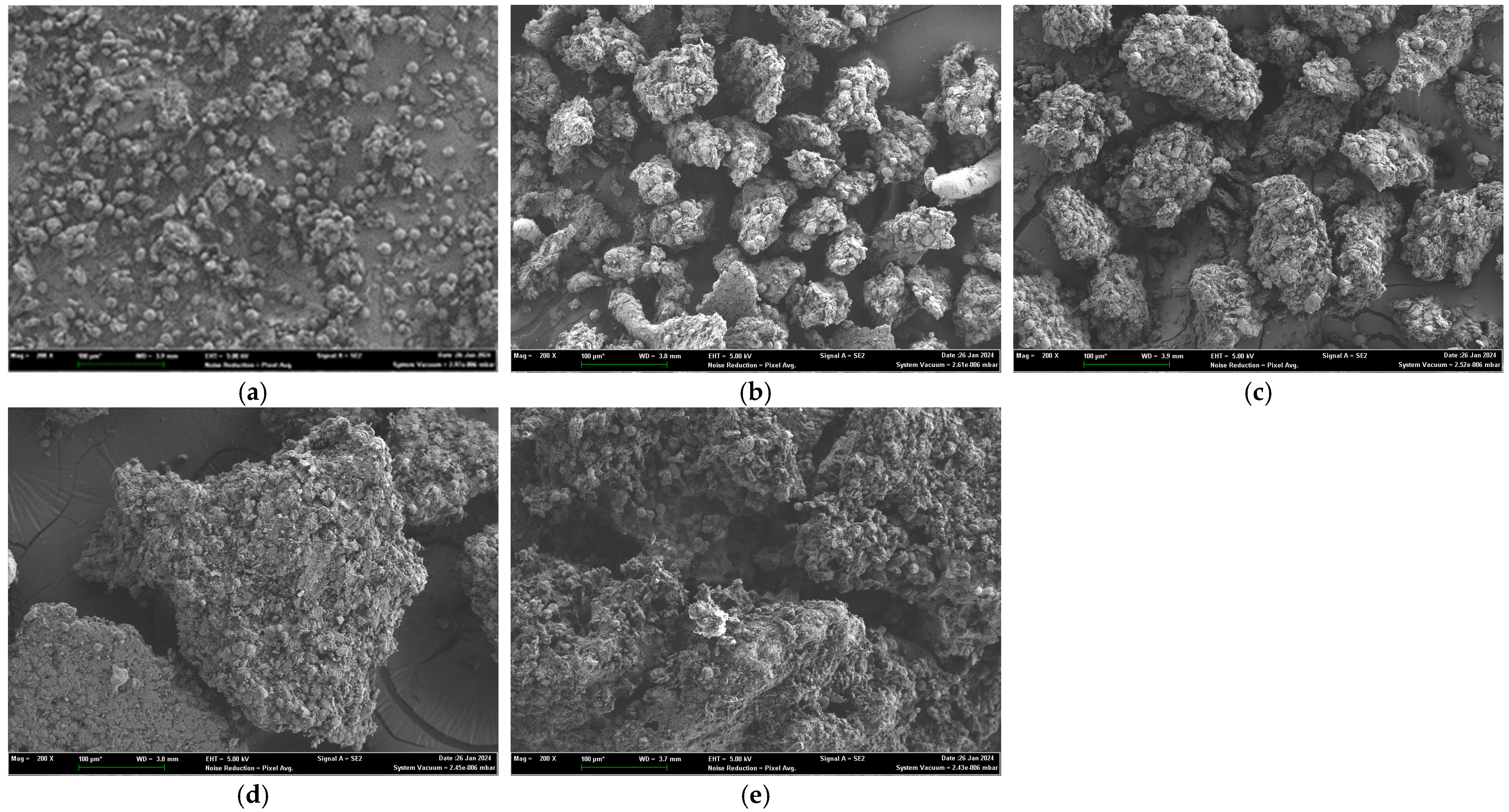

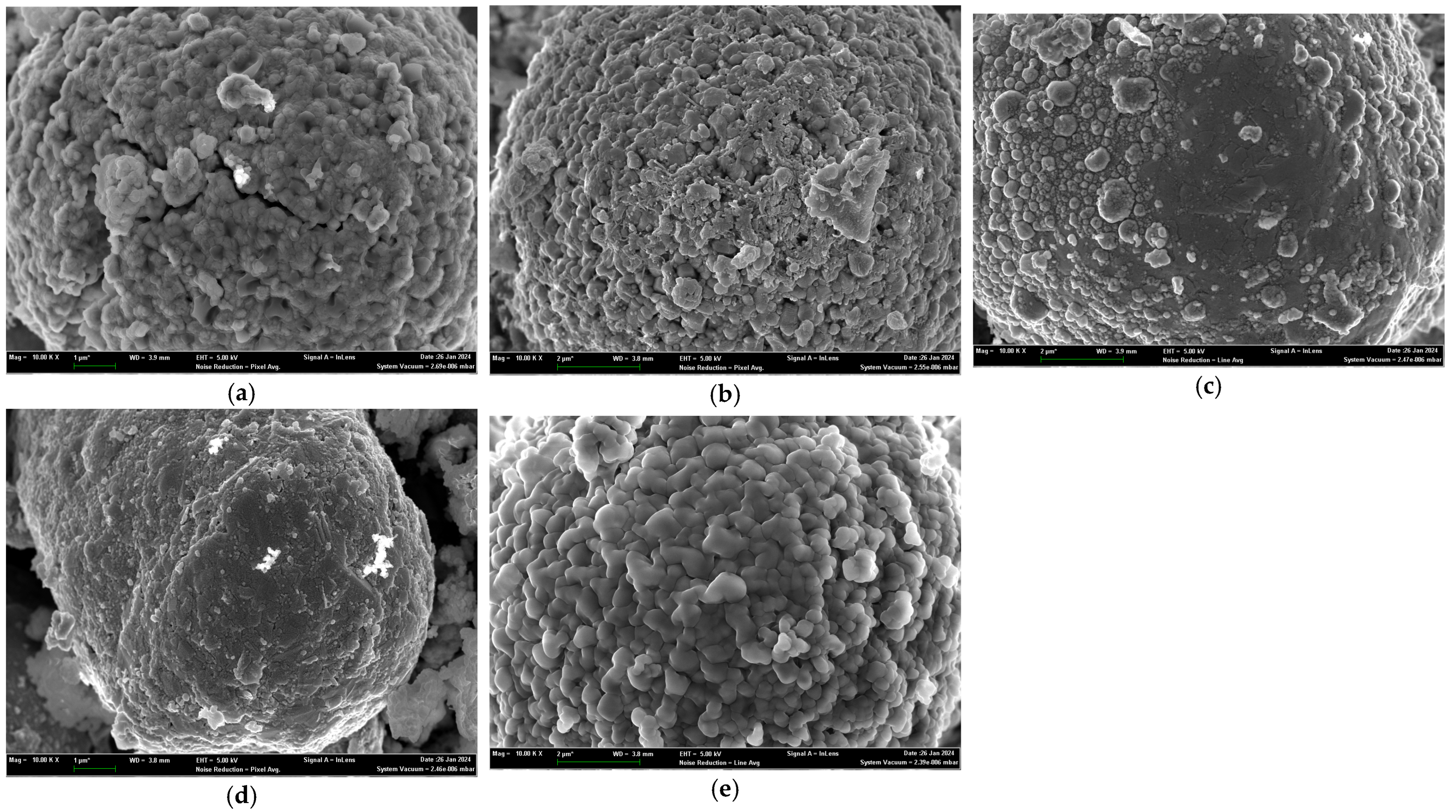
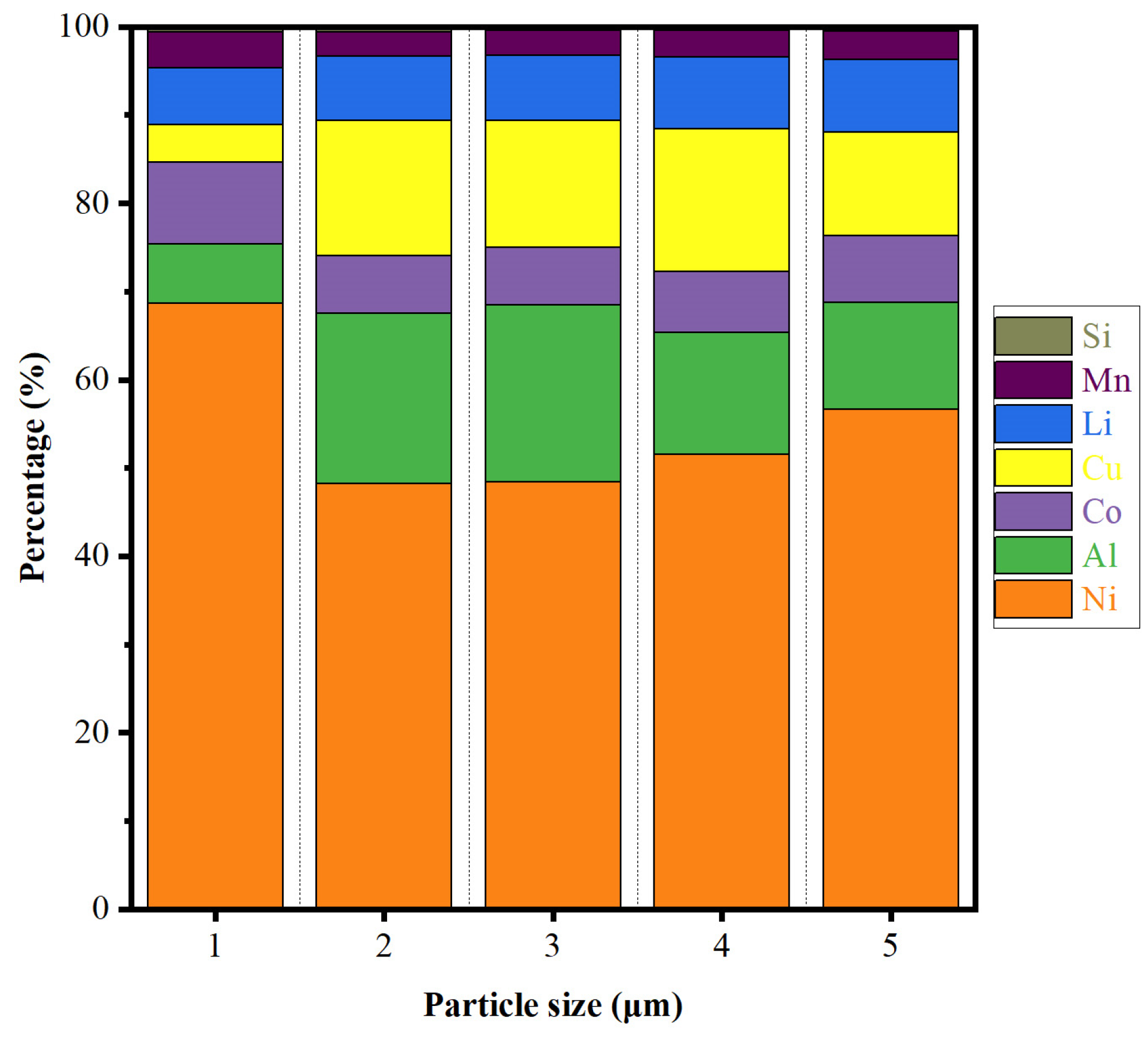
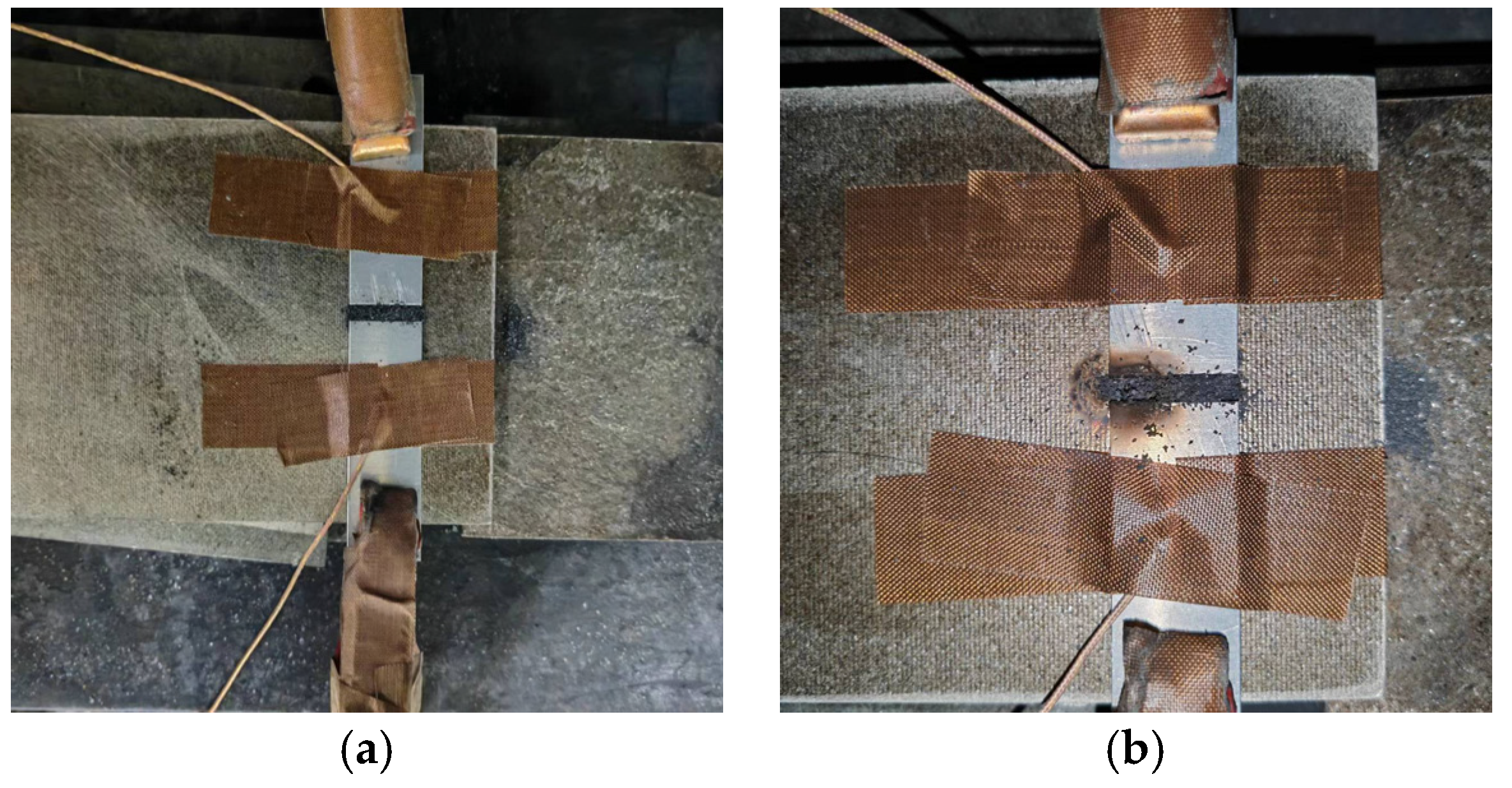
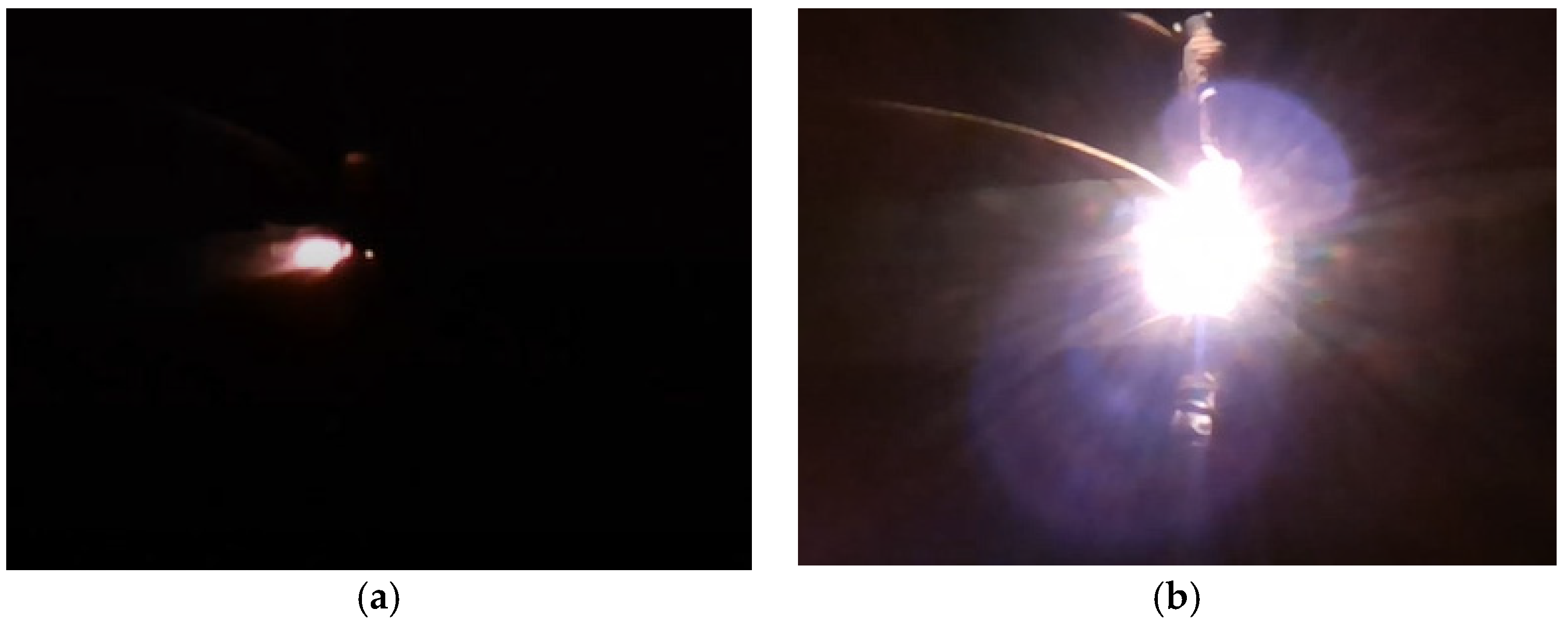
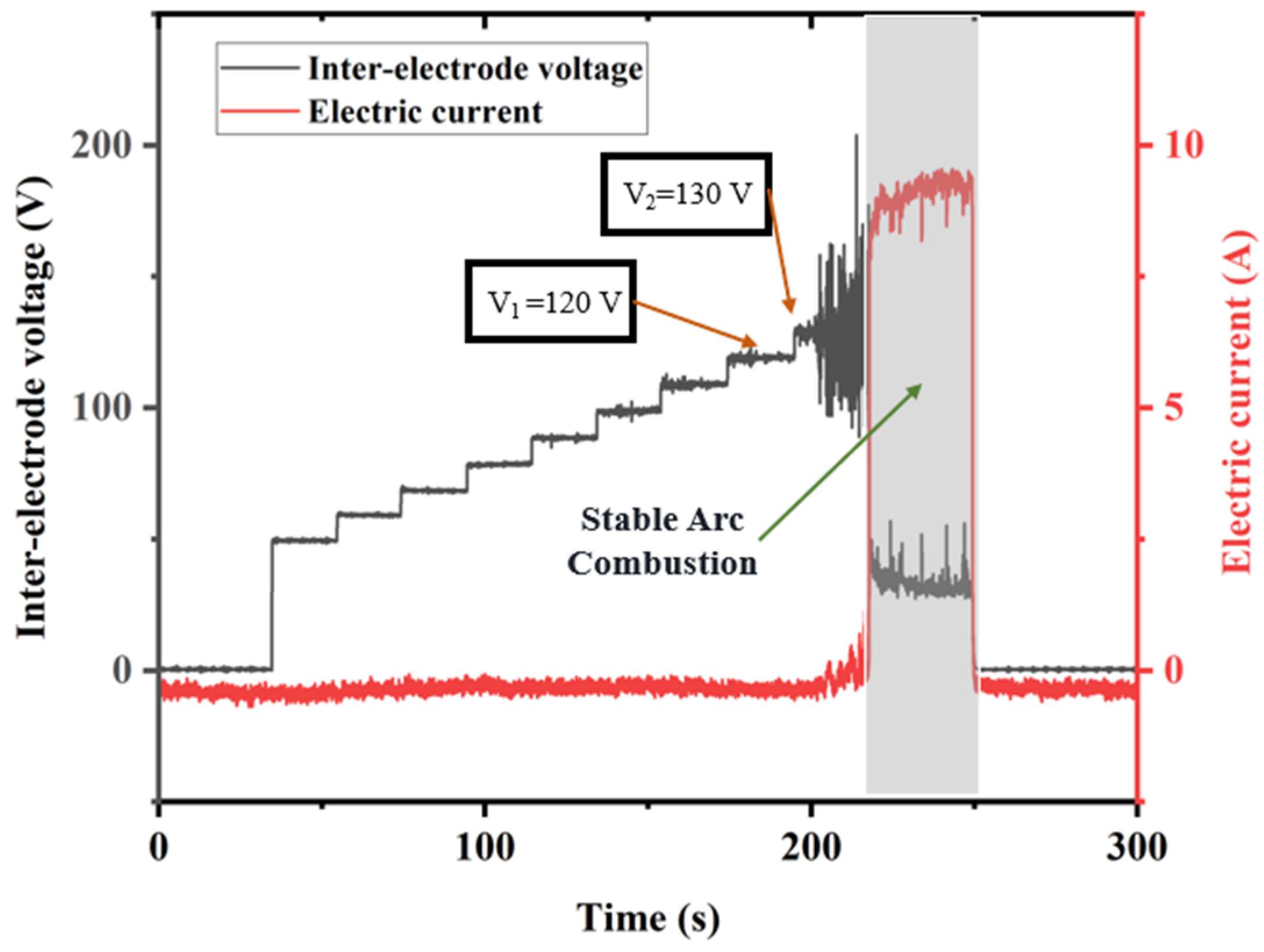
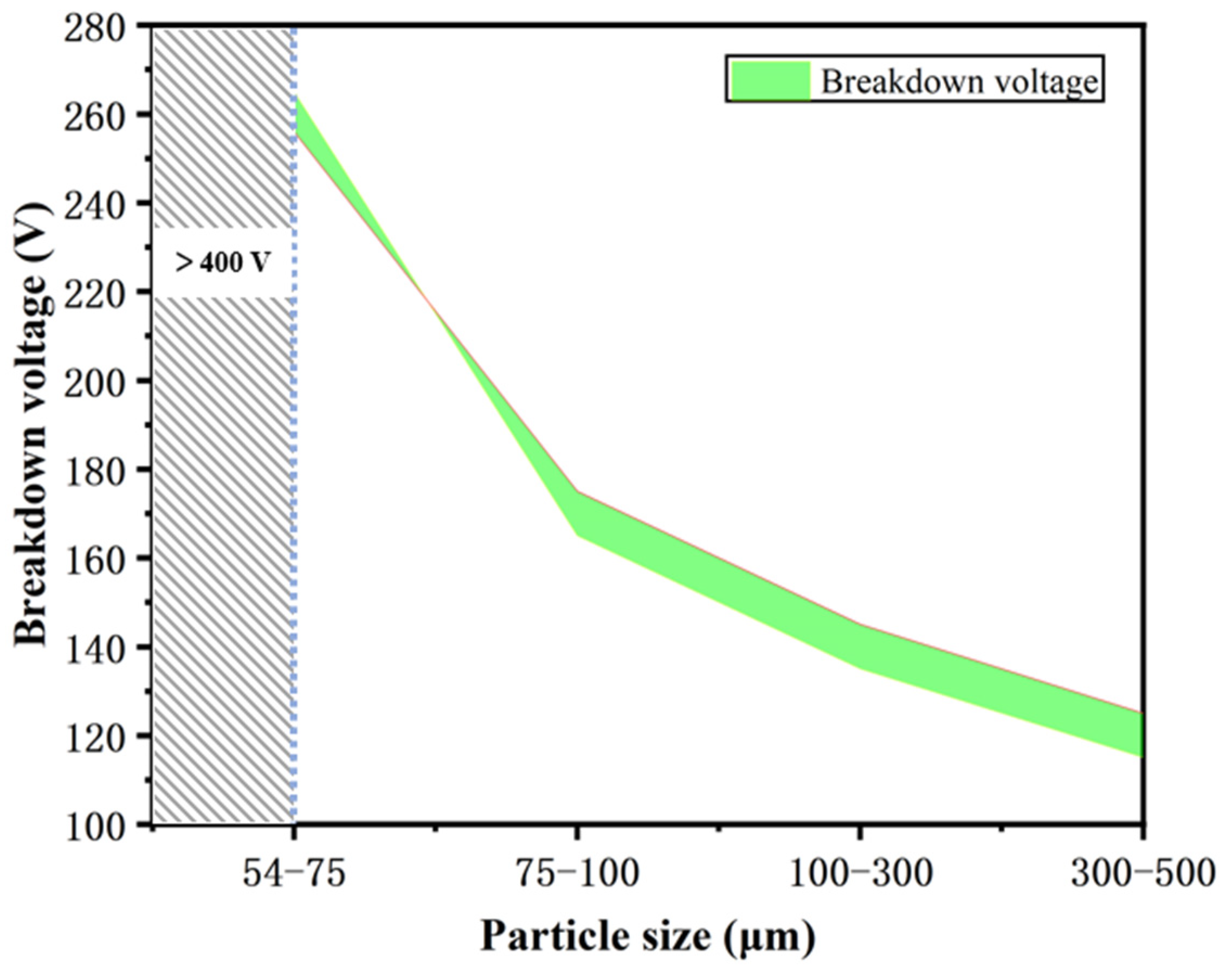
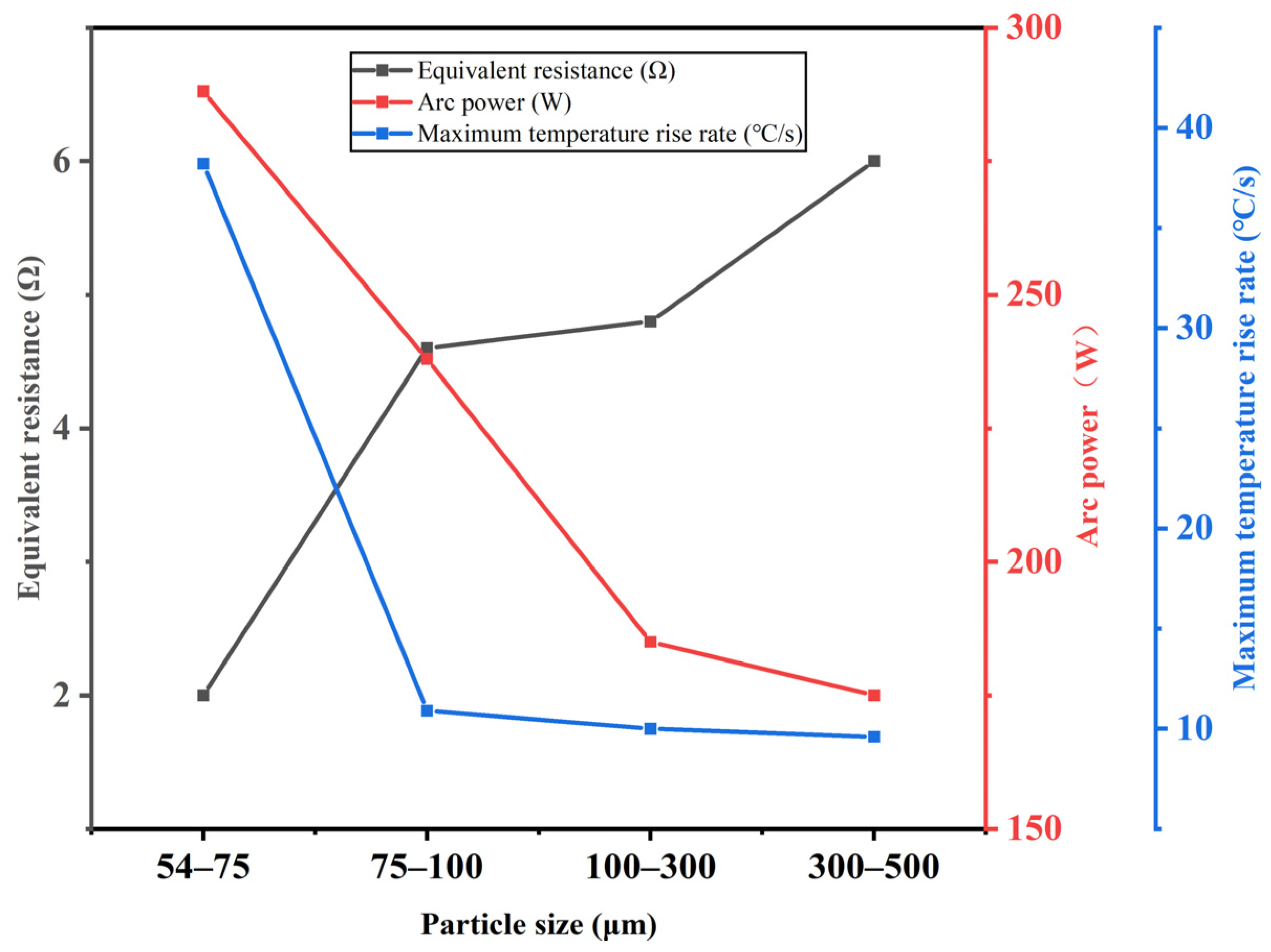


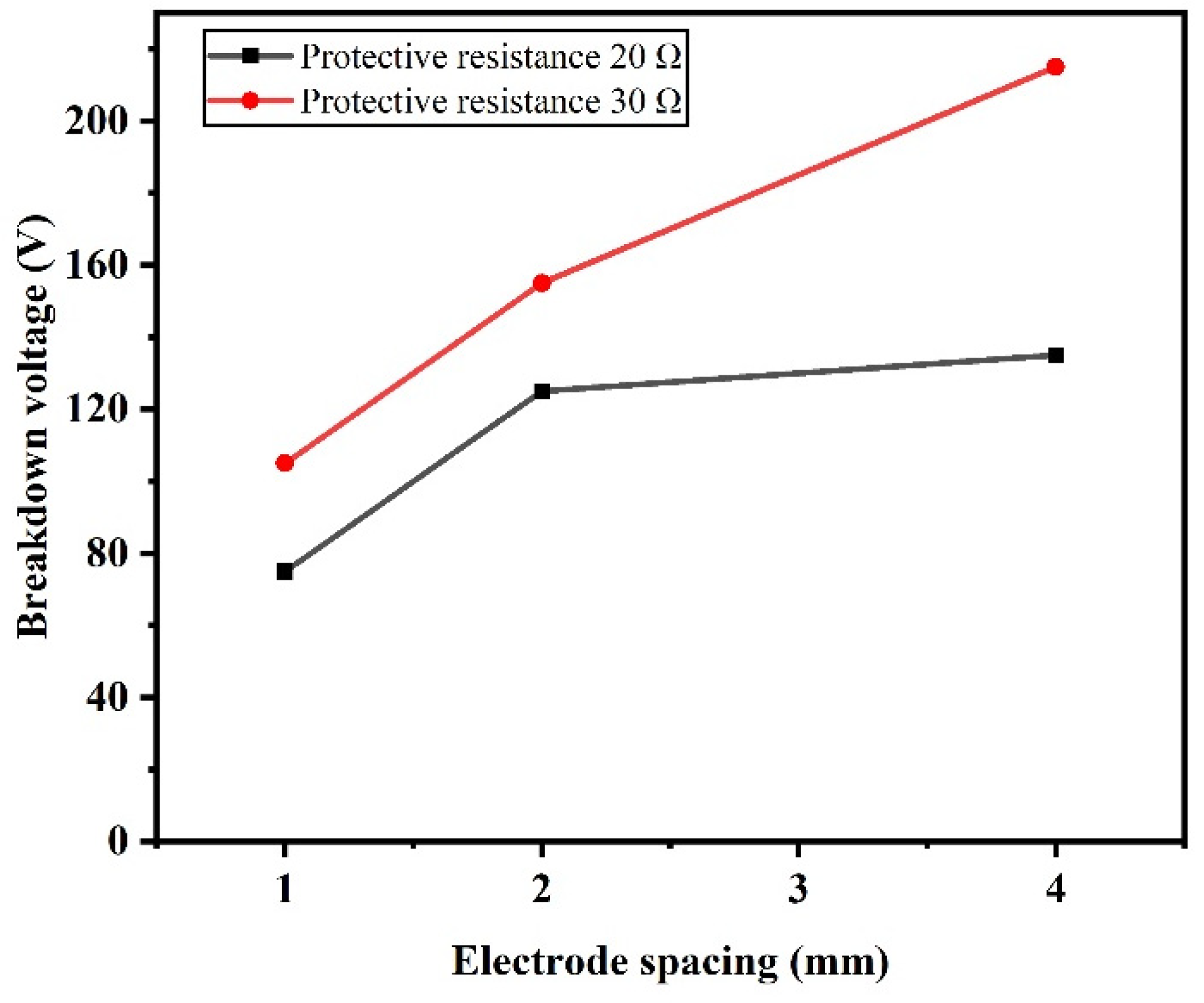
| Category | NCM811 |
|---|---|
| Shape | Pouch cell |
| Capacity (Ah) | 71 |
| Voltage ceiling (V) | 4.25 |
| Voltage floor (V) | 2.8 |
| Specific energy (Wh/Kg) | 331.6 |
| Battery weight (g) | 910 |
| State of charge (SOC) | 100% |
| Category | Composition |
|---|---|
| Anode | Graphite |
| Cathode current collector | Cu |
| Anode current collector | Al |
| Separator | Polyethylene (PE) |
| Salt | LiPF6 |
| Particle Size (μm) | D (0.1) 1 | D (0.5) | D (0.9) | Average Particle Size (μm) | Highest Proportion (μm) |
|---|---|---|---|---|---|
| 0–54 | 3.054 | 11.538 | 27.846 | 14.185 | 12.619 |
| 54–75 | 7.452 | 68.109 | 74.069 | 55.6 | 63.246 |
| 75–100 | 10.346 | 81.093 | 116.901 | 81.384 | 90.237 |
| 100–300 | 20.496 | 168.775 | 326.968 | 178.776 | 200 |
| 300–500 | 113.876 | 361.002 | 644.56 | 375.681 | 447.744 |
| Particle Size (μm) | 0–54 | 54–75 | 75–100 | 100–300 | 300–500 |
|---|---|---|---|---|---|
| C | 59.5 | 44.8 | 60 | 60.7 | 71.9 |
| O | 11.4 | 10.9 | 14 | 15 | 18.3 |
| F | 3.8 | 3.1 | 3.2 | 3.5 | 3 |
| Al | 1.7 | 12.6 | 6.7 | 1.9 | 0.6 |
| Si | 0.3 | 0 | 0.1 | 0 | 0.2 |
| P | 1.1 | 0.8 | 1.1 | 1.1 | 0.8 |
| Mn | 1.2 | 1.4 | 0.7 | 1.3 | 0.4 |
| Co | 2.6 | 3.4 | 1.6 | 2.5 | 0.7 |
| Ni | 18.2 | 23 | 12.5 | 14 | 3.8 |
| Cu | 0.2 | 0 | 0.1 | 0 | 0.3 |
| Particle Size (μm) | 0–54 | 54–75 | 75–100 | 100–300 | 300–500 |
|---|---|---|---|---|---|
| Al | 3.38 | 10.1 | 10.6 | 6.7 | 6.15 |
| Co | 4.63 | 3.42 | 3.44 | 3.38 | 3.86 |
| Cu | 2.13 | 8.05 | 7.57 | 7.9 | 5.94 |
| Li | 3.23 | 3.81 | 3.91 | 3.92 | 4.16 |
| Mn | 2.03 | 1.48 | 1.48 | 1.48 | 1.68 |
| Ni | 34.4 | 25.3 | 25.5 | 25.1 | 28.8 |
| Si | 0.29 | 0.29 | 0.22 | 0.21 | 0.23 |
Disclaimer/Publisher’s Note: The statements, opinions and data contained in all publications are solely those of the individual author(s) and contributor(s) and not of MDPI and/or the editor(s). MDPI and/or the editor(s) disclaim responsibility for any injury to people or property resulting from any ideas, methods, instructions or products referred to in the content. |
© 2024 by the authors. Licensee MDPI, Basel, Switzerland. This article is an open access article distributed under the terms and conditions of the Creative Commons Attribution (CC BY) license (https://creativecommons.org/licenses/by/4.0/).
Share and Cite
Chen, Y.; Li, Y.; Wang, J.; Lu, L.; Wang, H.; Li, M.; Xu, W.; Shi, C.; Li, C. Characterization of Breakdown Arcs Induced by Venting Particles Generated by Thermal Runaway of Large-Capacity Ternary Lithium-Ion Batteries. Electronics 2024, 13, 3168. https://doi.org/10.3390/electronics13163168
Chen Y, Li Y, Wang J, Lu L, Wang H, Li M, Xu W, Shi C, Li C. Characterization of Breakdown Arcs Induced by Venting Particles Generated by Thermal Runaway of Large-Capacity Ternary Lithium-Ion Batteries. Electronics. 2024; 13(16):3168. https://doi.org/10.3390/electronics13163168
Chicago/Turabian StyleChen, Yuhao, Yalun Li, Juan Wang, Languang Lu, Hewu Wang, Minghai Li, Wenqiang Xu, Chao Shi, and Cheng Li. 2024. "Characterization of Breakdown Arcs Induced by Venting Particles Generated by Thermal Runaway of Large-Capacity Ternary Lithium-Ion Batteries" Electronics 13, no. 16: 3168. https://doi.org/10.3390/electronics13163168






